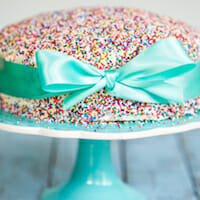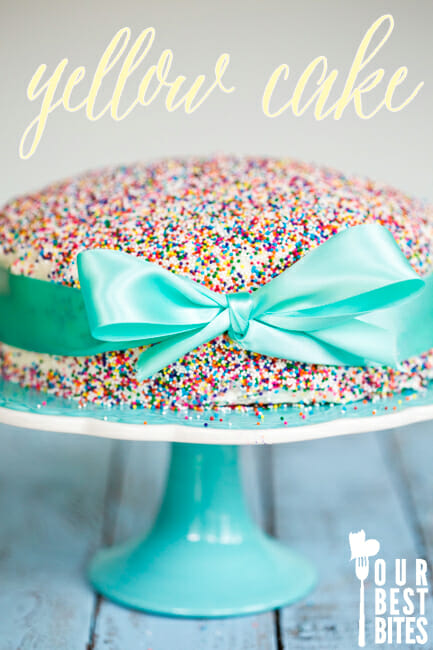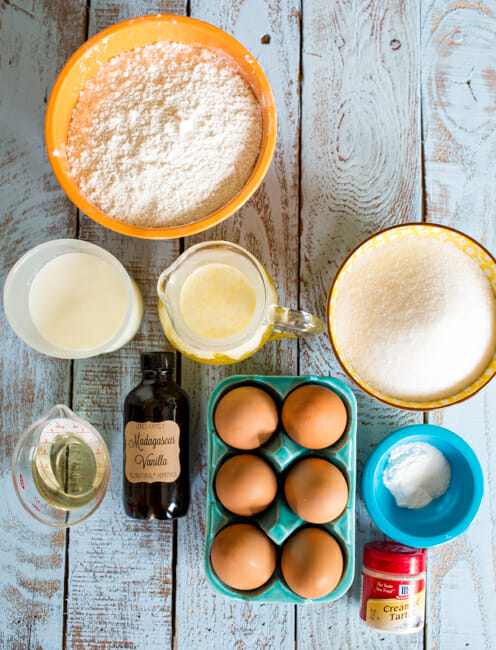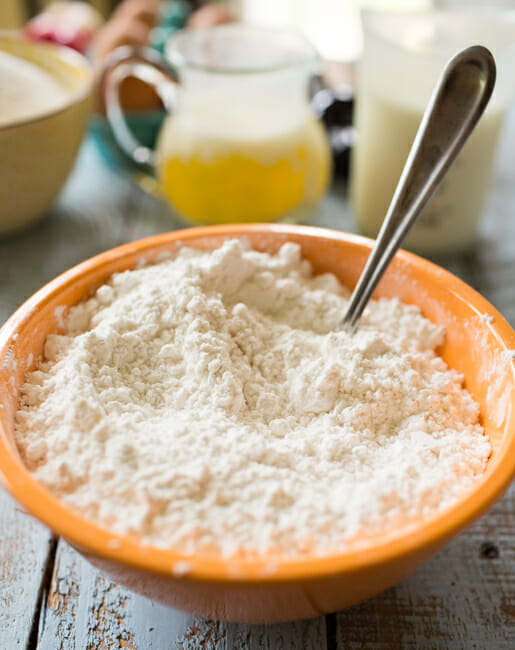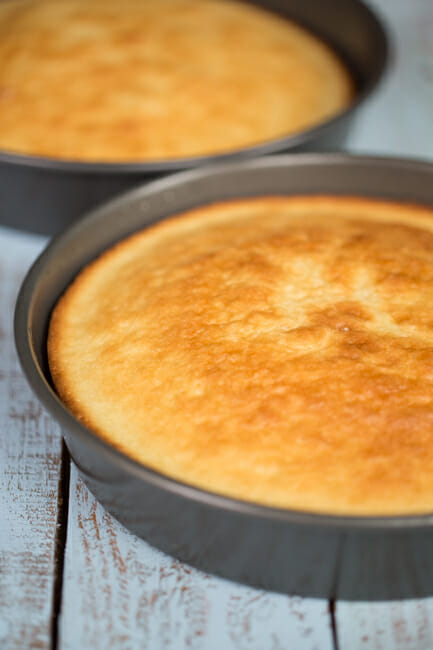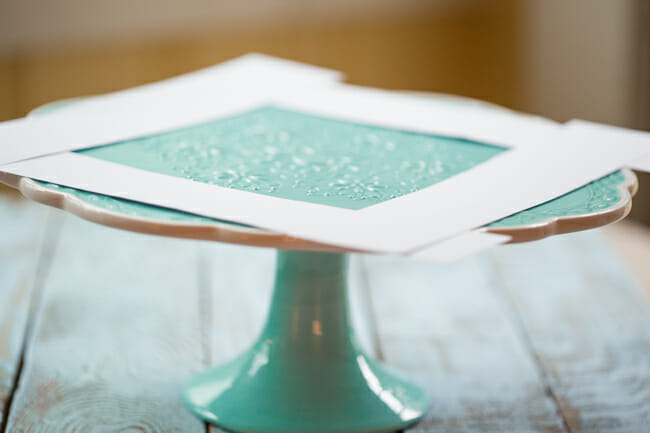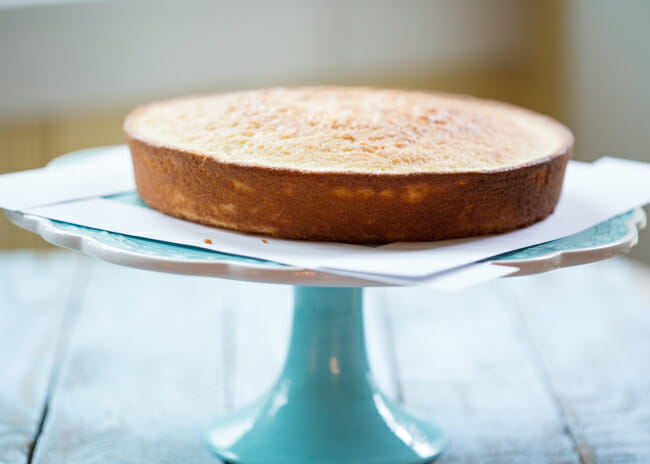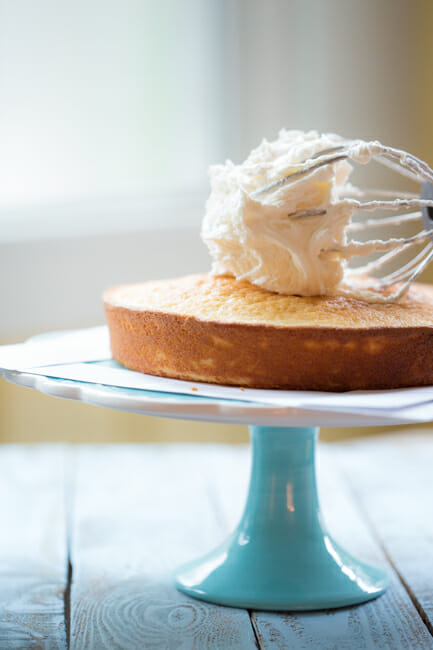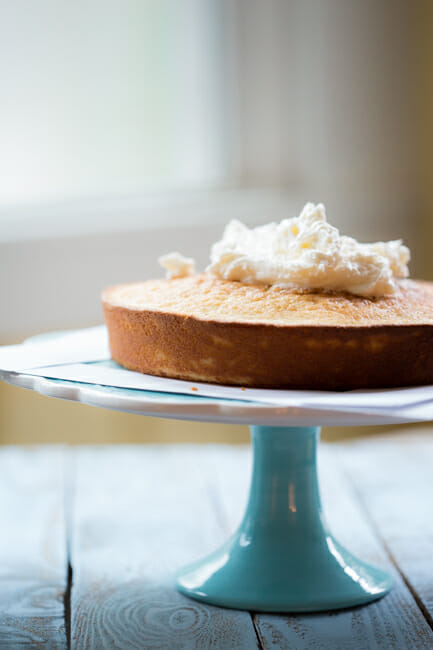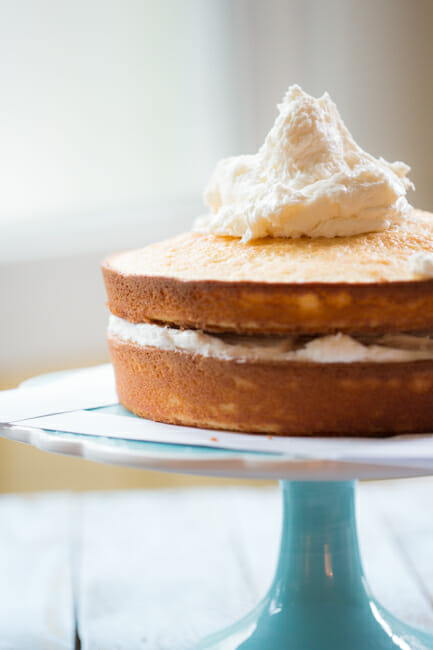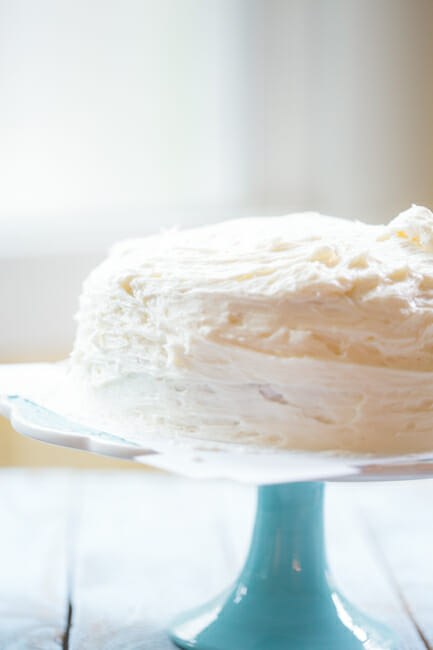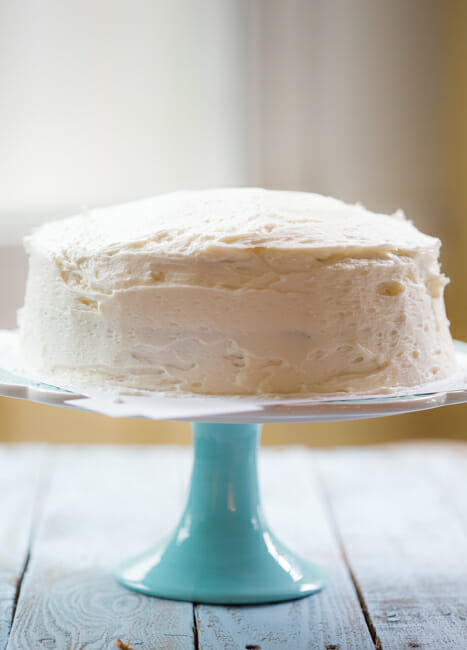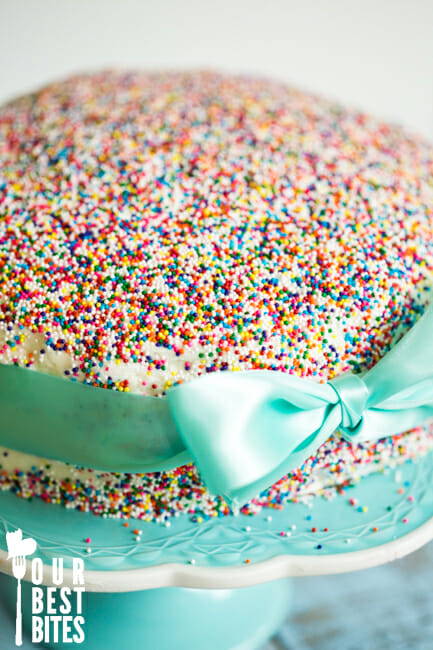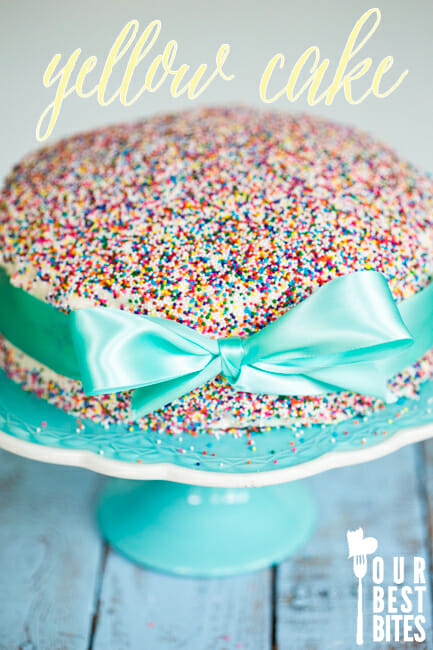You guys…this was the cake that almost didn’t happen. It was like the forces of evil were trying to prevent me from sharing the cakey goodness. Maybe that’s a tiny bit dramatic. But everything just seemed unnecessarily hard, you know? As it turns out, I almost jumped ship halfway through the baking process, then I ended up coming back and finishing it, then making it again 12 hours later to make sure I hadn’t messed things up. In the meantime, Sara and I are in the throes of developing recipes for our next cookbook (eeeeek!! Also, those of you who are concerned about our shortage of dinner recipes lately, that’s because we’re throwing all our dinner-making energies into that book–it’s going to be a big-time dinner book!), so I had a cake on my counter, a cake in my oven, and a pot roast slow cooking, which you’d think would make me the happiest girl in the world, but really, it just made me super grumpy that I had about 10 million dishes to do, that my big kids were running wild, that Will had watched Frozen at least twice, and that I hadn’t showered at 4:00 pm. A really awesome yellow cake has been on my list for a long time. It’s become a more urgent situation because I’ve always fallen back on our doctored up cake mix recipes, but within the last year or so, all the cake mixes, even my beloved Duncan Hines Supreme, have reduced the amount of cake mix per box, and since math is not in any way my forte, I can’t figure out how to accurately reduce the extra ingredients. The problem is that yellow cakes are notoriously finicky. They are just hard to make well. I don’t know why. Mine have always come out either eggy (ew) or super dry. I heard good things about the Cook’s Illustrated yellow cake, so I started making it and taking pictures along the way just in case. Now. I love and respect Cook’s Illustrated/America’s Test Kitchen/Cook’s Country. A lot. But as I was working my way through the recipe, I found it uncharacteristically difficult to follow–some things were unclear and other directions got lost along the way. In an attempt to clarify a particularly tricky egg yolk situation, I got online and started reading about how this was a terrible, dry, flavorless cake. And I got spooked. I left everything on the table, grabbed my daughter, and we went to get cupcakes because I had cake on the brain and this cake wasn’t gonna happen. By the time I got home, my head had cleared a little. I started wondering if other people had been just as confused by the recipe, particularly the egg yolk situation, and that’s why their cakes were dry. So I took a leap of faith that would inevitably end in a lot of dirty dishes and added all the extra egg yolks. Thankfully, it worked. It was delicious. Amazing. Flavorful, Moist, but not too moist, firm but not dry, it cut like a dream. Of course, all that happened at, like, 10 pm, so I slapped on some frosting from the Tim Riggins Brownies and did a lot of dishes (side note: anyone who says that homemade cakes are just as easy as cakes from a box are not telling you the truth. Boxed cake mixes use 1, ONE bowl. This was a harsh reality.) So I figured I’d try again the next day, bake the cakes in the morning and then frost and photograph it in the afternoon. And I woke up to blackness. There was a massive rainstorm and I had, like, zero natural light. Which meant I had to lug out my tripod and hope for the best. The good news is that the second cake was just as delicious, so I know it wasn’t a happy accident. But. it’s really important to follow the recipe exactly as it’s written. If you don’t have a kitchen scale, I can’t make you buy one, but it really gets more than use than just about any kitchen appliance I have, large or small. I haven’t really adapted much of the actual recipe (I tweaked some salt and vanilla, nothing major). But I did try to make the directions more clear. I’m not sure if how I did things was how they meant for them to be done, but I’ve had really good success twice with this method.
You’re going to need cake flour, baking powder, baking soda, salt, sugar, buttermilk, butter, vegetable oil, vanilla, eggs, and cream of tartar.
Adjust oven racks to the medium position and preheat oven to 350 degrees. Grease 2 9″ cake pans and set aside. In a large bowl, whisk the flour, baking powder, baking soda, salt, and 1 1/2 cups of the sugar together. Set aside.
In a medium bowl, whisk together the butter, vegetable oil, vanilla, buttermilk, and (this is where I gave up the first time around) 6 egg yolks. Set aside. Place 3 egg whites (discard the others, or use them for something healthy like an egg white omelet to negate the cake. Or something.) in the bowl of a stand mixer. Add a pinch of cream of tartar. Using the whisk attachment, beat on medium-low for about a minute or until they become frothy. Increase the speed to medium-high until soft peaks form. Increase speed to high and slowly add the remaining 1/4 cup sugar and beat until the whites are glossy and stiff peaks form. Transfer to another bowl. Place the flour mixture into the bowl of the stand mixer and slowly add the butter mixture, mixing over low speed. Scrape down the bowl and then mix on medium-low until smooth and fully mixed. Remove the bowl from the mixer. Use a rubber spatula to fold in 1/3 of the egg whites, fold in another 1/3, mix, then fold in the remaining 1/3 of the egg whites and gently fold until no white streaks remain. Divide the batter evenly among two pans and tap the pans on the counter gently to release bubbles. Bake in the preheated oven for 20-22 minutes or until a toothpick inserted into each pan comes out clean. Allow to cool on a wire rack for 10 minutes,
then remove from the pans and allow to cool completely before frosting. To make the frosting, place 1 cup salted butter, 6 cups powdered sugar, and 2 teaspoons vanilla extract in the bowl of a stand mixer and mix on low until the butter and sugar start together. Add enough milk to reach a frosting-y consistency and beat on high until light and fluffy. Add additional milk if necessary. To assemble the cake, place four strips of paper on the plate, forming a square.
Place one cake layer on the plate
and add a dollop of frosting.
Smooth it out, then add the second layer
and frost the top.
Carefully frost the sides. Smooth it out with a frosting knife or a butter knife.
If desired, cover in sprinkles (add about 2 tablespoons at a time and gently press them into the cake.
To sprinkle the sides, pour them into your palm and gently press it into the sides.) Carefully remove the paper strips and voila!
Makes 12 servings.
Ingredients: 2 1/2 cups (10 ounces) cake flour (people at very high elevations should add an additional 2 tablespoons) 1 1/4 teaspoons baking powder 1/4 teaspoon baking soda 1/2 teaspoon salt 1 3/4 cups sugar, divided 1 cup buttermilk, room temperature 10 tablespoons salted butter, melted and cooled slightly 3 tablespoons vegetable oil 1 tablespoon vanilla extract 6 room temperature eggs, separated (you’ll need 6 yolks and 3 whites; you can discard the extra whites) Pinch of cream of tartar Optional: at least 1 cup rainbow sprinkles FROSTING: 1 cup salted butter 6 cups powdered sugar 2 teaspoons vanilla extract (or more to taste) Enough milk to reach desired consistency; it should be firm enough to hold a layer cake together without sliding but not so firm that it’s difficult to spread Instructions: Adjust oven racks to the medium position and preheat oven to 350 degrees. Grease 2 9″ cake pans and set aside. In a large bowl, whisk the flour, baking powder, baking soda, salt, and 1 1/2 cups of the sugar together. Set aside. In a medium bowl, whisk together the butter, vegetable oil, vanilla, buttermilk, and 6 egg yolks. Set aside. Place 3 egg whites (discard the others, or use them for something healthy like an egg white omelet to offset the sugar bomb we have here) in the bowl of a stand mixer. Add a pinch of cream of tartar. Using the whisk attachment, beat on medium-low for about a minute or until they become frothy. Increase the speed to medium-high until soft peaks form. Increase speed to high and slowly add the remaining 1/4 cup sugar and beat until the whites are glossy and stiff peaks form. Transfer to another bowl. Place the flour mixture into the bowl of the stand mixer and slowly add the butter mixture, mixing over low speed. Scrape down the bowl and then mix on medium-low until smooth and fully mixed. Remove the bowl from the mixer. Use a rubber spatula to fold in 1/3 of the egg whites, fold in another 1/3, mix, then fold in the remaining 1/3 of the egg whites and gently fold until no white streaks remain. Divide the batter evenly among two pans and tap the pans on the counter gently to release bubbles. Bake in the preheated oven for 20-22 minutes or until a toothpick inserted into each pan comes out clean. Allow to cool on a wire rack for 10 minutes, then remove from the pans and allow to cool completely before frosting. To make the frosting, place 1 cup salted butter, 6 cups powdered sugar, and 2 teaspoons vanilla extract in the bowl of a stand mixer and mix on low until the butter and sugar start together. Add enough milk to reach a frosting-y consistency and beat on high until light and fluffy. Add additional milk if necessary. To assemble the cake, place four strips of paper on the plate, forming a square. Place one layer on the plate and add a dollop of frosting. Smooth it out, then add the second layer and frost the top. Carefully frost the sides. Smooth it out with a frosting knife or a butter knife. If desired, cover in sprinkles (add about 2 tablespoons at a time and gently press them into the cake. To sprinkle the sides, pour them into your palm and gently press it into the side.) Carefully remove the paper strips. Makes 12 servings.
